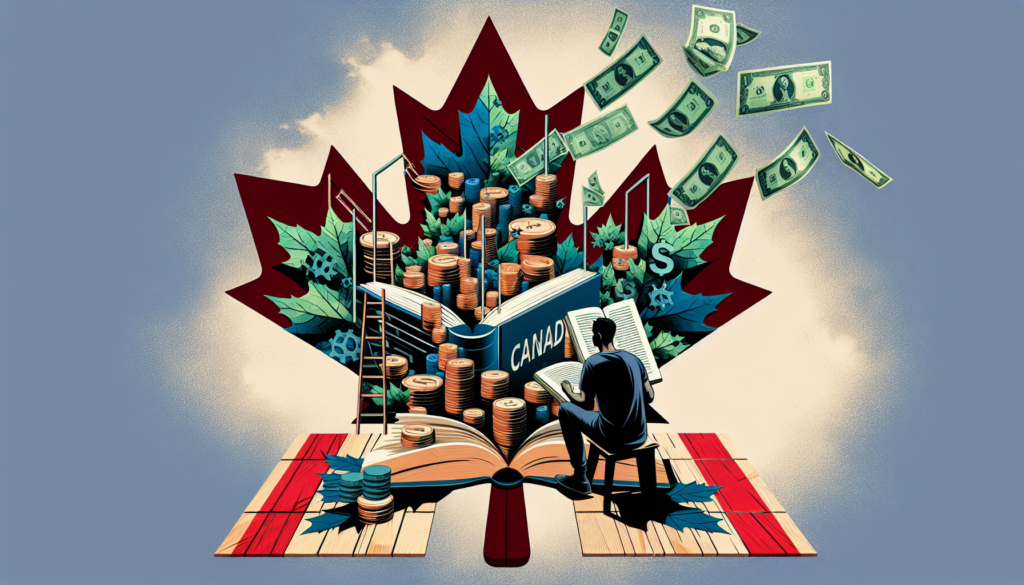Capital gains tax in Canada marks a crucial component in understanding how investments and the disposal of capital assets such as real estate, stocks, or businesses affect personal and corporate finances. It operates on the principle that only 50% of the profit from selling these assets is taxable, making it integral to strategic financial planning for Canadian residents, encompassing both individuals and corporations. This tax not only influences decisions about asset sales but also plays a significant role in overall tax management, considering the capital gains are added to other income and taxed according to marginal tax rates.
Navigating the nuances of capital gains tax in Canada demands a comprehensive understanding of its application, from exceptions like the principal residence exemption to strategies such as tax loss harvesting and the utilization of capital cost allowance. BOMCAS Canada, as a professional tax consultancy, stands ready to guide through the complexities of capital gains tax, aiding in making informed decisions that align with financial goals and tax minimization strategies. This article aims to unravel the intricacies of capital gains tax, its recent changes, impacts, and strategic considerations to optimize tax outcomes for both individuals and corporations in Canada.
What is Capital Gains Tax?
Capital Gains Tax (CGT) in Canada is a tax levied on the profit made from the sale of an asset that has increased in value. This includes assets such as real estate, stocks, and bonds. The taxable amount is determined by subtracting the asset’s cost base, which includes the purchase cost and any associated expenses, from the sale price. Notably, only 50% of the realized gain is subject to tax, which is then added to the individual’s total income and taxed at their marginal rate.
Key Aspects of Capital Gains Tax
- Calculation of Taxable Gain: The first step in calculating CGT is determining the Adjusted Cost Base (ACB), which is the cost of acquiring the asset plus any related expenses. The taxable gain is then calculated by subtracting the ACB from the sale price. This gain is halved, as only 50% of capital gains are taxable in Canada.
- Utilization of Losses: Capital losses can offset capital gains, reducing the overall taxable income. These losses can be carried back to any of the three preceding years or carried forward indefinitely, providing a strategic tax planning tool to minimize tax liabilities.
- Special Exemptions and Rules: Several exemptions can significantly reduce CGT. The principal residence exemption, for instance, allows individuals to avoid taxes on the sale of their primary home under specific conditions. Additionally, the lifetime capital gains exemption for 2023 is set at $971,190 for qualified small business corporation shares, which can substantially benefit small business owners.
Strategies to Mitigate Capital Gains Tax
Investors and taxpayers can adopt several strategies to reduce their capital gains tax burden. These include investing through tax-advantaged accounts like Tax-Free Savings Accounts (TFSAs), which shield earnings from taxes, and timing the sale of assets to coincide with years of lower personal income to benefit from lower tax rates. Moreover, BOMCAS Canada, as a professional tax consultancy, provides expert advice on navigating these strategies effectively, ensuring that individuals and corporations optimize their tax positions while adhering to Canadian tax laws.
Recent Changes to Capital Gains Tax in Canada
The 2024 Canadian budget has introduced significant amendments to the capital gains tax (CGT) structure, specifically targeting high earners and certain business entities. These changes are set to reshape the financial planning landscape for a small segment of the population and various corporations across Canada.
Overview of New CGT Regulations
- Inclusion Rate Adjustment: The capital gains inclusion rate will increase from 50% to 66.67%. This adjustment will apply to individuals on capital gains exceeding $250,000 and to all capital gains realized by corporations and trusts.
- Effective Date and Applicability: These changes are slated to take effect from June 25, 2024. For individuals, the higher rate kicks in for gains over $250,000, while for corporations and trusts, the new rate applies to all capital gains.
- Expected Revenue and Fiscal Impact: The government anticipates that this adjustment will generate substantial revenue, estimated at $19.4 billion over five years, beginning in 2024-25. This revenue is intended to support new governmental projects and programs.
Implications for Specific Groups and Assets
- High-Income Individuals: Only 0.13% of Canadians, who typically have an average income of about $1.4 million annually, are expected to be impacted by this change.
- Businesses and Trusts: All corporations and trusts will face the full two-thirds inclusion rate on their capital gains, which has raised concerns regarding potential negative impacts on investment and entrepreneurship.
- Real Estate and Other Major Assets: The new rules also affect those planning to sell secondary vacation homes, inherited properties, or income properties. Significant impacts are also anticipated for estates due to these changes.
Strategic Considerations
Given the substantial changes, individuals and corporations are advised to consult with professional tax accountants, such as those from BOMCAS Canada, to navigate the new CGT landscape effectively. Strategies may include realizing gains before the new rules take effect or reevaluating investment plans to align with the upcoming fiscal environment.
Implications for Different Income Groups
The recent adjustments to the capital gains tax in Canada have significant implications for different income groups, with a particular impact on high earners and the wealthiest segments of society.
Equity in Taxation Across Income Levels
The proposed changes aim to establish a more equitable distribution of tax burdens across various income groups. By increasing the average federal-provincial marginal tax rate on capital gains above $250,000 for individuals earning $1 million annually to 35.7%, the government seeks to balance the tax rates across different sources of revenue. This adjustment affects a small fraction of Canadians, specifically only 0.13% who have an average income of $1.4 million, indicating a targeted approach towards high earners.
Tax Contributions by Income Groups
The distribution of tax contributions in Canada reveals a significant skew towards higher income groups. In 2021, the top 1% of income earners contributed 22.5% of all income taxes, while the top 10% accounted for 54.4% of the total income tax collected. This trend is consistent with the broader economic structure where the top 20% of income-earning families are responsible for 61.9% of all personal income taxes and 53.1% of total taxes. These statistics highlight the substantial financial responsibility shouldered by higher income groups in supporting public expenditures.
Wealth Distribution and Tax Advantages
The capital gains tax structure in Canada has historically favored the wealthy, who disproportionately benefit from capital gains advantages compared to the middle class. This disparity is further evidenced by the concentration of wealth, where the wealthiest 20% of Canadians hold more than two-thirds of the total net wealth. In contrast, the bottom 40% of net income earners account for just under 3% of total wealth. Despite these inequities, middle-class Canadians continue to benefit from certain tax provisions such as tax-free savings accounts, the principal residence exemption, and exemptions for registered pension plans, which help mitigate some of the disparities in tax advantages.
By addressing these issues through the recent changes to the capital gains tax, the government aims to foster a fairer tax system that can adapt to economic needs, such as increasing revenue to manage national debt. For personalized advice and strategies related to these tax changes, BOMCAS Canada, a professional tax consultancy, is available to assist individuals and corporations navigate the evolving tax landscape.
Capital Gains Tax for Corporations and Trusts
Overview of Capital Gains Tax Rates for Corporations and Trusts
Corporations and trusts in Canada are set to face significant changes in their capital gains tax obligations. Starting June 25, 2024, both entities will be taxed at an increased two-thirds rate on all capital gains, a substantial rise from the previous 50% inclusion rate. This adjustment is part of a broader strategy to ensure tax fairness and increase public revenue without harming Canada’s competitiveness in the global market.
Tax Compliance and Business Impact
The elevation in capital gains tax rates for corporations, especially private ones, could complicate tax compliance and increase the overall tax burden for these entities. Analysts predict that Canada’s attractiveness as a business location might decline, particularly affecting small and medium-sized enterprises that are already grappling with various fiscal pressures. This could lead to a reevaluation of investment strategies and operational adjustments to mitigate the increased financial strain.
Specific Tax Rules for Corporate Entities
Canadian corporate tax structure is intricate, with specific rules applicable to different types of income and transactions:
- Dividends between Canadian corporations are generally deductible, reducing taxable income, although dividends from certain preferred shares incur a 10% tax.
- Non-resident corporations must pay Capital Gains Tax on gains from the sale of taxable Canadian property.
- Complex rules govern cross-border transactions, including securities lending and surplus stripping, which are subject to Withholding Tax and other regulatory requirements.
- Corporate entities also benefit from specific provisions allowing for the tax-effective repatriation of income from foreign affiliates, under certain conditions.
For detailed guidance on navigating these changes, corporations and trusts can consult with professional tax accountants like BOMCAS Canada, which specializes in Canadian capital gains tax.
Impact on Investment Strategies
The recent legislative changes to the capital gains tax in Canada are poised to significantly influence investment strategies across the board. Particularly, investors are urged to consider the timing of their asset sales and the structure of their investment vehicles to maintain tax efficiency and optimize returns. Here is a detailed look at how these changes could reshape investment approaches:
Timing of Realizing Capital Gains
- Pre-Change Advantage: Investors have a critical window of opportunity to realize capital gains at a lower tax rate before the new inclusion rate takes effect on June 25, 2024. Acting within this timeframe could result in substantial tax savings, especially for those with large unrealized gains.
- Long-Term Strategy Adjustments: Post-June 2024, investors might need to rethink the timing of their asset sales, considering the increased tax burden. This might involve holding onto investments longer or choosing more opportune moments when personal income might be lower, thus potentially falling into a lower tax bracket.
Diversification and Tax Efficiency
- Portfolio Diversification: Building a tax-efficient, diversified portfolio remains a cornerstone strategy for wealth accumulation and growth acceleration. This involves a mix of various investment types, each with different tax implications, to balance potential risks and returns.
- Tax-Efficient Investment Vehicles: Utilizing registered plans like RRSPs and TFSAs can shield some investments from taxes, which becomes increasingly important in a higher tax environment. Understanding which investments to hold inside versus outside registered plans can significantly impact the overall tax efficiency of an investment portfolio.
Corporate and Entrepreneurial Adjustments
- Corporate Investment Structures: The increase in capital gains tax for corporations might discourage the use of holding corporations as investment vehicles due to the disruption of the principle of integration, which could lead to double taxation on distributed profits.
- New Relief Measures for Entrepreneurs: Despite the increased tax rates, business owners and entrepreneurs could benefit from new relief measures, such as an increased Lifetime Capital Gains Exemption and the Canadian Entrepreneurs’ Incentive, which aim to mitigate some of the increased tax impacts and support business investment.
The evolving landscape of capital gains taxation necessitates a strategic review of investment portfolios and business structures. For those seeking tailored advice, BOMCAS Canada offers professional consultation to navigate these changes effectively, ensuring alignment with personal and business financial goals.
Comparing Canada’s Capital Gains Tax with Other G7 Countries
Capital Gains Tax Rates: Canada vs. G7 Countries
Canada’s approach to capital gains tax is notably different from its G7 counterparts. In Canada, only 50% of capital gains are taxable, which is incorporated into an individual’s income and taxed at ordinary rates. This relatively lower inclusion rate offers a tax advantage, as it effectively reduces the Marginal Effective Tax Rate (METR) on capital gains, positioning Canada as an attractive destination for investment within the G7.
Comparative Analysis of G7 Capital Gains Tax Rates
| Country | Capital Gains Tax Rate for Individuals | Corporate Capital Gains Tax Rate | Additional Notes |
|---|---|---|---|
| Canada | 50% of the gain added to income | Same as individual rate | Favorable METR |
| United States | 20% | 21% (Federal rate) | – |
| United Kingdom | Up to 28% depending on income bracket | 19% (Corporation tax) | – |
| Germany | 25% | 26.375% plus church tax | – |
| Japan | 15% to 39.64% | 20.315% | – |
| Italy | 26% | Same as individual rate | – |
| France | 30% plus 4% for high earners | 28% (2020 rate) | – |
Global Positioning and Tax Implications
Canada’s favorable tax treatment of capital gains does not distinguish between residents and non-residents, applying uniformly to all. This inclusive approach, combined with the lowest METR in the G7, enhances Canada’s reputation as a lucrative and equitable environment for both domestic and international investors. In contrast, other G7 nations have higher and more variable capital gains tax rates, which can influence investment decisions and economic growth differently. For instance, Japan and France impose significantly higher rates for individuals, which might deter personal investments in certain asset classes.
For detailed guidance on how these international differences in capital gains taxation might affect investment decisions, entities like BOMCAS Canada offer expert advice, helping investors and corporations navigate the complexities of tax planning across different jurisdictions.
Exceptions and Exemptions under New Rules
Lifetime Capital Gains Exemption (LCGE) Adjustments
The Lifetime Capital Gains Exemption (LCGE) represents a significant relief for individuals dealing with the disposition of qualified properties. As of 2024, the LCGE for dispositions of Qualified Small Business Corporation Shares (QSBCS) is indexed to $1,016,836, reflecting an adjustment for inflation. This exemption, which has seen a progressive increase from $750,000 in 2008 to its current amount, underscores the government’s commitment to supporting small business owners and entrepreneurs.
For Qualified Farm or Fishing Property (QFFP), the exemption limit remains at a generous $1,000,000, providing substantial tax relief for individuals in these sectors. This specific exemption does not extend to QSBCS, indicating a targeted approach to encourage investments in farming and fishing industries.
Principal Residence Exemption Continuity
The Principal Residence Exemption remains a cornerstone of Canadian tax policy, offering homeowners the ability to exclude capital gains from the sale of their primary homes from taxable income. This exemption applies as long as the property has been the principal residence of the taxpayer or their family at any time during the ownership period. A change in the use of the property, such as converting a portion to a rental or business use, could affect the exemption’s applicability, which makes understanding these rules crucial.
Inheritance and Gift Considerations
In the context of gifts or inheritances, if these properties are later sold, the capital gains may be subject to taxation at the prevailing rates. It is important for recipients of such gifts or inheritances to be aware of the potential tax implications, especially with the recent increases in inclusion rates. For those concerned about these and other tax matters, professional advice from tax accountants such as BOMCAS Canada can provide crucial guidance and planning strategies to navigate the complexities of capital gains tax in Canada.
Strategies to Mitigate Capital Gains Tax
Utilizing Tax-Advantaged Accounts
- Tax-Free Savings Account (TFSA): Contributions to a TFSA are made with after-tax dollars, meaning withdrawals, which include the earnings from investments, are entirely tax-free.
- Registered Retirement Savings Plan (RRSP): An RRSP allows earnings within the account to grow tax-free until withdrawal. At withdrawal, taxes are due at the individual’s marginal rate, which could be lower in retirement than during working years.
- Registered Education Savings Plan (RESP): Contributions grow tax-free, and withdrawals made by the student for educational purposes are taxed at the student’s typically lower income rate.
Loss Utilization and Harvesting
- Offsetting Gains with Losses: If an investor incurs both gains and losses within the same year, they can offset each other, potentially reducing the capital gains tax to zero. This strategy is particularly useful in volatile markets.
- Tax-Loss Harvesting: By selling underperforming assets, investors can realize a loss, which can be used to offset any realized gains. This strategy not only helps in reducing the current year’s tax liability but can also carry forward unused losses to future years.
Strategic Asset Disposition
- Timing of Sale: Investors should consider the timing of asset sales to manage their tax burden effectively. Selling assets when income is expected to be lower, such as during retirement, can result in a lower tax rate on capital gains.
- Charitable Contributions: Donating securities or other investment assets to charity can offer a dual benefit—the capital gains on the donated assets are not taxed, and the donor receives a tax receipt for the fair market value of the donated assets, which can be used to offset other income.
For those navigating complex scenarios or significant portfolios, professional advice from tax experts like BOMCAS Canada can provide tailored strategies that align with personal financial goals while optimizing tax liabilities.
Conclusion
Navigating the complexities of capital gains tax in Canada can be a daunting task, both for individuals and corporations alike. However, with a detailed exploration of topics ranging from the calculation and mitigation strategies to the impact of recent legislative changes and comparisons with G7 countries, this article provides a comprehensive guide aimed at demystifying these intricacies. BOMCAS Canada, as Canada’s professional tax accountants, stands ready to assist with personalized advice and strategies, ensuring that taxpayers can navigate these changes with confidence and optimize their financial outcomes in alignment with Canada’s tax laws.
The strategic considerations highlighted within this guide underscore the importance of proactive financial planning and consultation with tax professionals. As the landscape of capital gains tax in Canada continues to evolve, particularly with the upcoming changes in the inclusion rate for high earners, corporations, and trusts, seeking expert advice from entities like BOMCAS Canada is more crucial than ever. By staying informed and leveraging professional guidance, taxpayers can effectively navigate the complexities of capital gains tax, ensuring they are well-positioned to make informed decisions that align with their financial goals and comply with Canadian tax regulations.










Pingback: Canadian Corporate Tax: An In-depth Analysis for Entrepreneurs and Corporations - Jahplay.com
Pingback: Demystifying Capital Gains Tax in Canada: An In-depth Analysis - Accountants Burnaby BC
Pingback: The Impact of Capital Gains Tax on Canadian Economy: An Analysis - Best Accounting Firm Canada
Pingback: Demystifying Canada’s Capital Gains Tax - topaccountingexperts.com